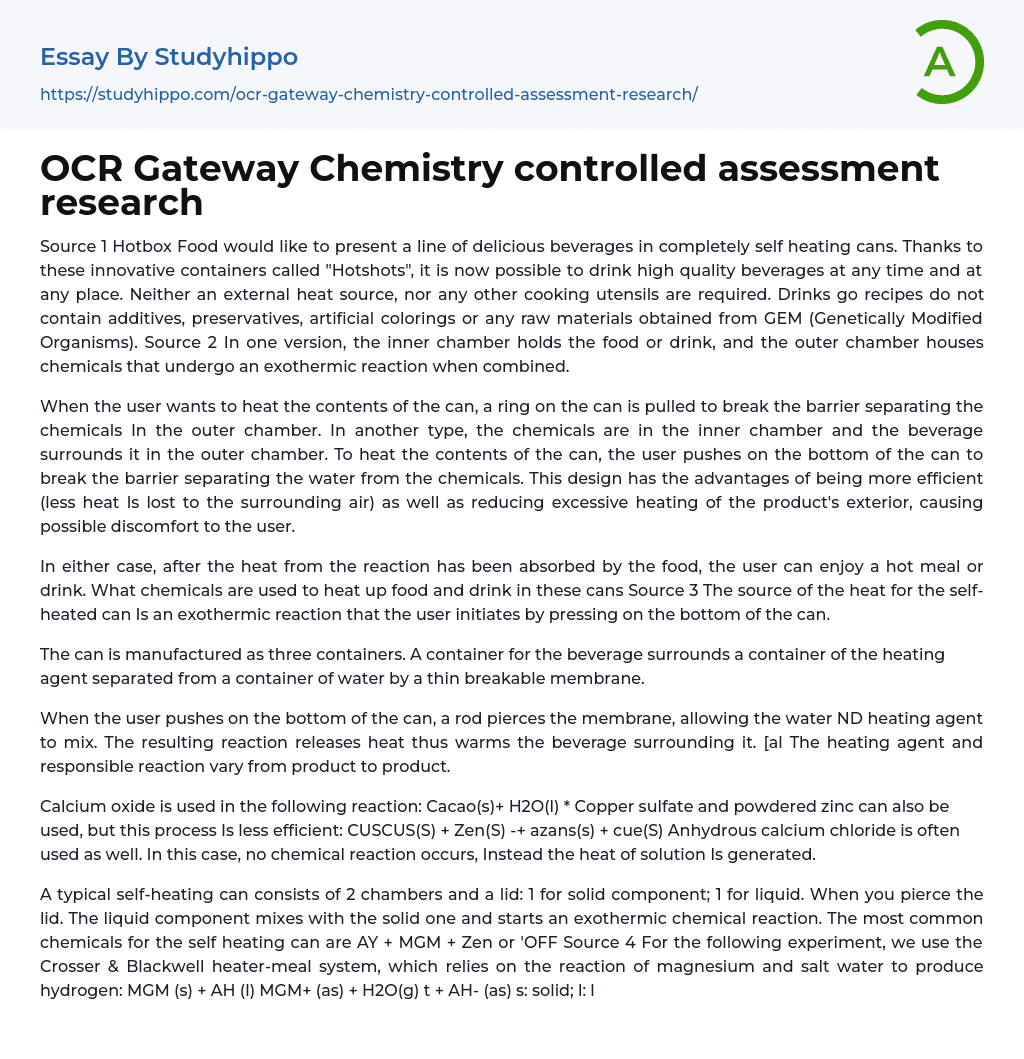

OCR Gateway Chemistry controlled assessment research Essay Example
Hotbox Food introduces their line of delicious self-heating beverages in innovative containers known as "Hotshots", allowing for high-quality drinks to be enjoyed at any time and place without the need for an external heat source or cooking utensils. Their recipes are free from additives, preservatives, artificial colorings, and raw materials obtained from GEM. The inner chamber of the self-heating can holds the food or drink while the outer chamber contains chemicals that react exothermically when combined. To activate the heating process, the user pulls a ring on the can to break the barrier between the outer chamber chemicals, or pushes on the bottom to separate water from inner chamber chemicals. This design is more efficient and prevents discomfort from excessive heat on the product's exterior. Once
...heated, users can enjoy a hot meal or drink.
The materials used to heat food and beverages in cans vary depending on the product. One type of self-heated can uses an exothermic reaction initiated by the user pressing on the bottom of the can. The can is made of three containers; a container for the beverage, a container of heating agent, and a container of water separated by a thin, breakable membrane. When the user pushes on the bottom of the can, a rod pierces the membrane allowing the heating agent and water to mix and create heat. Different products use different heating agents such as calcium oxide, copper sulfate and powdered zinc, or anhydrous calcium chloride. Another type of self-heated can has two chambers and a lid - one for a solid component and one for liquid. When the lid is pierced, the liquid mixes with
the solid and triggers an exothermic chemical reaction using chemicals such as AY, MGM, Zen or OFF.The Blackwell heater-meal system utilizes the reaction of magnesium and salt water to produce hydrogen. The chemical equation for the reaction is MGM (s) + AH (l) > MGM+ (as) + H2O(g) t + AH- (as). The letters s, l, g and as denote solid, liquid, gaseous and in solution states respectively. The reaction is initially slow due to visitation. Iron and salt are added to speed it up. Visitation is a process where a material becomes less reactive by forming a layer of oxide on its surface. To initiate heating, the self-heated can contains three containers – one for the beverage, another for the heating agent and the last for water, separated by a thin breakable membrane. When the user presses on the bottom of the can, a rod pierces the membrane allowing water and heating agents to mix, resulting in an exothermic reaction that releases heat and warms the beverage. Exothermic reactions transfer energy to the surroundings. Source 5 houses chemicals that react exothermically when combined.Exothermic reactions involve the transfer of energy as heat, which causes an increase in temperature in both the reaction mixture and its surroundings.This rise in temperature can be measured with a thermometer.Examples of exothermic reactions include combustion (burning), oxidation reactions (such as rusting), and neutralization reactions involving acids and alkalis.Some everyday applications of exothermic reactions include hand warmers and self-heating cans for beverages, which can reach high temperatures and release energy per gram in these chemical reactions. Self-heating cans, for instance, use a mixture of water and calcium oxide that, when activated,
heats up the beverage by 50 to 55 degrees Celsius within three minutes.The outer shell of the can also insulates the drink for approximately 45 minutes and ensures safety by preventing burns.The military uses magnesium and iron heaters in their Meals Ready to Eat or ration heaters.These heaters generate 310 calories per gram of heat energy upon activation and release hydrogen as a byproduct.Analogous items for civilians are also available, although it is rare to find individual packets sold by legitimate sellers.
- Oxygen essays
- Atmosphere essays
- Coral Reef essays
- Desert essays
- Earth essays
- Ocean essays
- Lake essays
- Sea essays
- Biodiversity essays
- Natural Environment essays
- Forest essays
- Soil essays
- Water essays
- Rainbow essays
- Ecosystem essays
- Volcano essays
- Wind essays
- Forestry essays
- Bottled Water essays
- Acid essays
- Calcium essays
- Carbohydrate essays
- Carbon essays
- Chemical Bond essays
- Chemical Reaction essays
- Chemical reactions essays
- Chromatography essays
- Concentration essays
- Copper essays
- Diffusion essays
- Ethanol essays
- Hydrogen essays
- Organic Chemistry essays
- Osmosis essays
- Periodic Table essays
- Ph essays
- Salt essays
- Sodium essays
- Titration essays
- Air Pollution essays
- Carbon Dioxide essays
- Climate essays
- Deforestation essays
- Ecology essays
- Endangered Species essays
- Environmental Issues essays
- Environmental Protection essays
- flood essays
- Greenhouse Gas essays
- Hurricane essays



